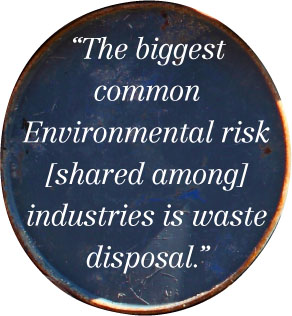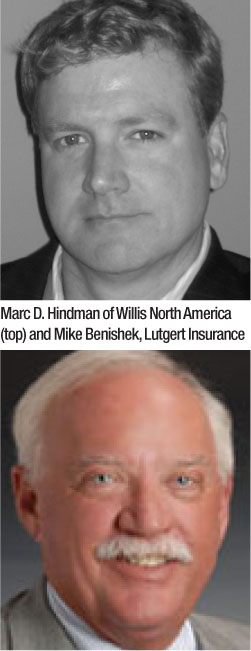While companies face many environmental regulations andchallenges that are specific to their industries, there are somebest practices when it comes to managing Pollution risk that cutacross all business sectors, experts say.
|“The key is to evaluate the potential exposure and develop awritten plan to mitigate potential impacts, starting with the mostsignificant,” says risk-engineering expert Doug Stohlman, aSacramento, Calif.-based regional manager at Zurich Services Corp.,a unit of Zurich North America.
| Exposures can be identified andevaluated through an environmental-impact statement; ASTM (formerlythe American Society for Testing and Materials) Phase I and PhaseII assessments; or other appraisal methods, Stohlman says. Allprovide the framework for developing appropriate mitigationmeasures.
Exposures can be identified andevaluated through an environmental-impact statement; ASTM (formerlythe American Society for Testing and Materials) Phase I and PhaseII assessments; or other appraisal methods, Stohlman says. Allprovide the framework for developing appropriate mitigationmeasures.
Stohlman adds that construction, manufacturing and energy risksmight be well advised to pay particular attention to how theiroperations could affect aquatic habitats, flora, fauna andbirds.
|PROACTIViTY IS A PRIORITY
|a company that proactively manages its Environmental risk likelywill prevent and minimize losses more effectively than those thatdon’t, says Craig Richardson, an Atlanta-based senior vicepresident at Ace USA.
|“Operations that adhere to proactive pollution-preventioninitiatives and are able to anticipate emerging trendssubstantially reduce their potential Environmental exposures,”Richardson asserts. “Although complying with environmentalregulation might ensure adequate cleanup of a spill, proactiveEnvironmental risk management might prevent it from happening inthe first place.”
|To that end, Richardson says, there must be a commitment fromtop management to loss prevention, which includes a commitment ofsufficient resources.
|In addition, he says, waste producers should:
|• Conduct periodic environmental-compliance audits.
|• Implement an environmental-management system.
|• Ensure that environmental-related recordkeeping anddocumentation is easily retrievable and not scattered throughoutthe organization.
|• Establish a process that keeps the organization up to date onall developments in environmental regulations and laws.
|• Coordinate and effectively communicate environmentalactivities throughout the organization, since Environmental riskrarely is controlled by one department.
|Extensive communication of environmental assessments,regulations, loss-prevention and safety measures, and all bestpractices throughout an organization is critical, adds GeneWingert, Environmental loss control manager at the Chubb Group ofInsurance Cos.
| That means managers, workers and contractorsmust be in the loop, Wingert stresses. For example, in a largeconstruction project, which can involve hundreds of contractors,subcontractors and suppliers, making clear to everyone who ismanaging the project’s Environmental exposure is critical forensuring “everyone is on the same page,” he says.
That means managers, workers and contractorsmust be in the loop, Wingert stresses. For example, in a largeconstruction project, which can involve hundreds of contractors,subcontractors and suppliers, making clear to everyone who ismanaging the project’s Environmental exposure is critical forensuring “everyone is on the same page,” he says.
Risk Transfer & Transportation
|risk advisor and former agribusiness risk manager Mike Benisheknotes that “the biggest common Environmental risk [shared among]industries is waste disposal.”
|While waste may be beyond a producer’s control while it’s beingdisposed of, an accident during transit still could create enormousliabilities for the producer.
|Contracts with waste haulers or recyclers—which should belicensed and bonded and in sound financial shape—should includeseveral provisions that transfer risk to the vendor, says Benishek,an account executive and risk-management advisor at LutgertInsurance, an agency in Sarasota, Fla.
|Benishek advises that the contracts stipulate:
|• The waste producer is selling or giving all of its waste tothe vendor.
|• The vendor is solely liable for any downstream recycling,product manufacturing or disposal of the waste.
|• Any future EPA charges related to remediation of landfillcontamination will be the vendor’s responsibility.
|• The vendor agrees to indemnify, defend and hold harmless thewaste producer.
|Benishek also suggests requiring the vendor to post aperformance bond with adequate limits to cover a potential landfillcleanup several decades in the future.
|One contract provision that a waste producer should not insiston is being named as an additional insured on a vendor’s insurancecoverage, Benishek asserts. In the event of a pollution incident,that provision could create several problems for a waste producer,he says.
|Even if a vendor’s Professional Liability insurer agrees tocover a waste producer’s third-party claims, the producer thenmight be subject to the policy’s deductible or self-insuredretention (SIR), Benishek notes.
|Plus, when seeking to recover compensation for its own damages,the waste producer likely would run afoul of the insured vs.insured exclusion in the vendor’s policy, Benishekexplains.
|Perhaps the waste producer could get itself named on all of thevendor’s insurance policies, but the coverages might be inadequateand the producer still could run into the SIR and insured vs.insured problems, according to Benishek.
|Sustainability & Risk Avoidance
|the most effective loss-prevention measure is risk avoidance,notes Marc D. Hindman, Atlanta-based chief risk control officer andregional practice leader of the Strategic Outcomes Practice groupat Willis North America. That is the approach a small but growingnumber of companies are taking with sustainability programs,Hindman notes.
|By implementing lean manufacturing processes, companies generatean often-unintended byproduct: reduced waste streams. Less wastemeans lower expenses—and “that hits the bottom line” as greaterprofits, Hindman notes.
|Many Fortune 1000 companies have adopted asustainability component to their lean processes in a formal effortto minimize their environmental footprint.
|For example, pharmaceutical manufacturer Genentech reducedits hazardous waste by 75 percent over several years by researchingand developing production processes that do not require usingchemical solvents, Hindman says.
|Biotech company Human Genome Sciences Inc.—where Hindman was onstaff—took a similar approach to Genentech and achieved similarresults, he says.
|All of this is grabbing the attention of socially responsibleinvestors, who now have a few corporate-sustainability scorecardsto consult before making their investment decisions, Hindmannotes.

Want to continue reading?
Become a Free PropertyCasualty360 Digital Reader
Your access to unlimited PropertyCasualty360 content isn’t changing.
Once you are an ALM digital member, you’ll receive:
- All PropertyCasualty360.com news coverage, best practices, and in-depth analysis.
- Educational webcasts, resources from industry leaders, and informative newsletters.
- Other award-winning websites including BenefitsPRO.com and ThinkAdvisor.com.
Already have an account? Sign In
© 2024 ALM Global, LLC, All Rights Reserved. Request academic re-use from www.copyright.com. All other uses, submit a request to [email protected]. For more information visit Asset & Logo Licensing.








